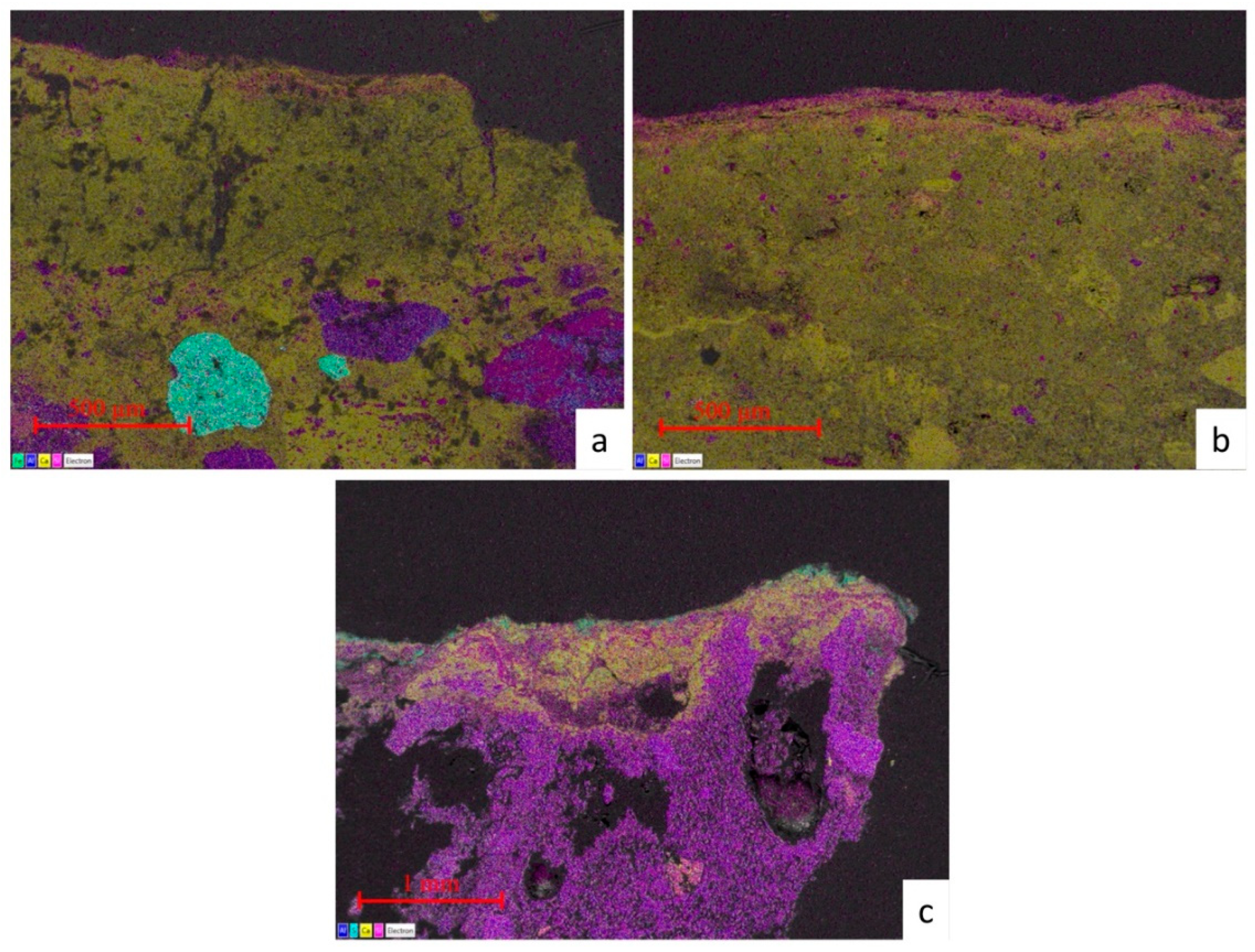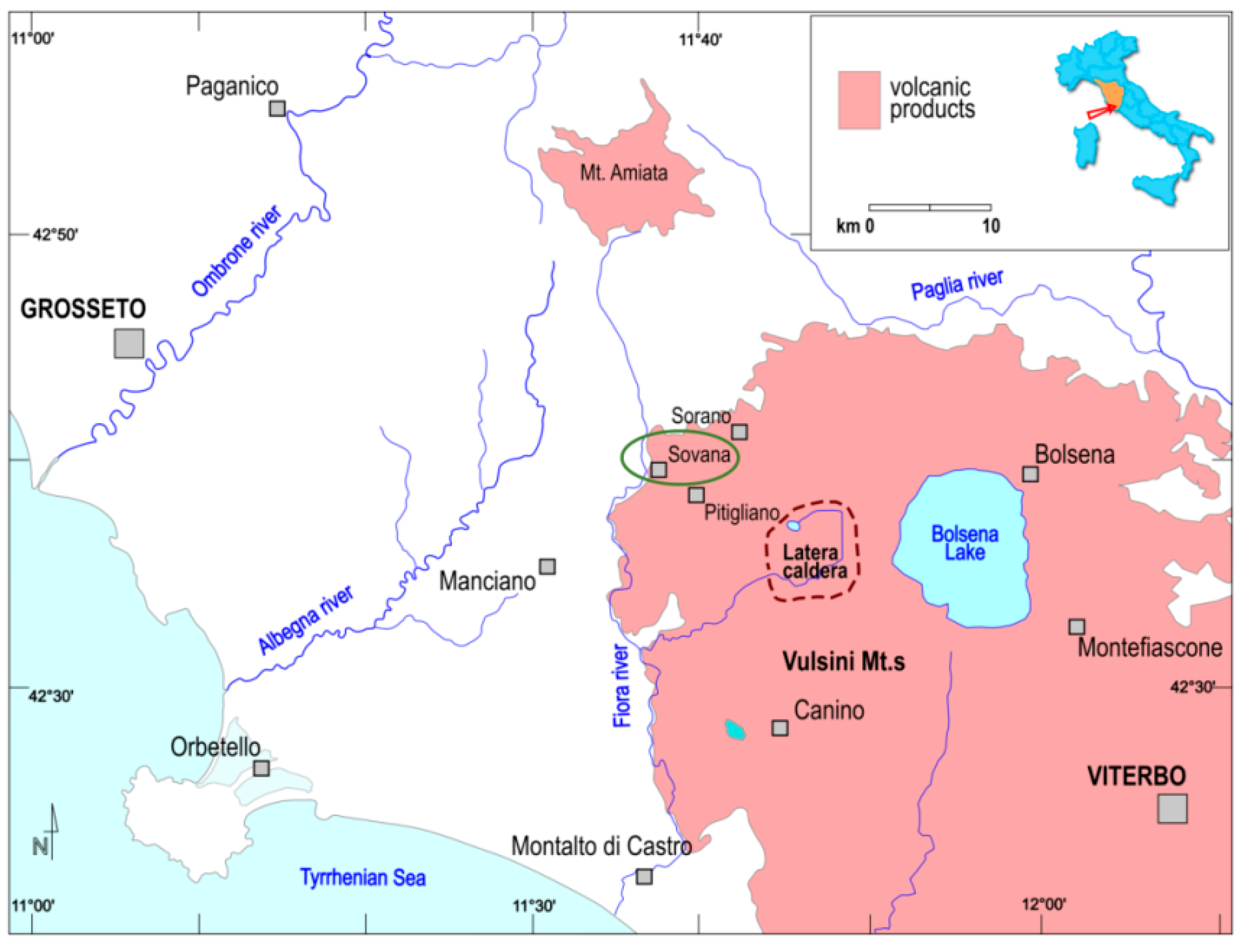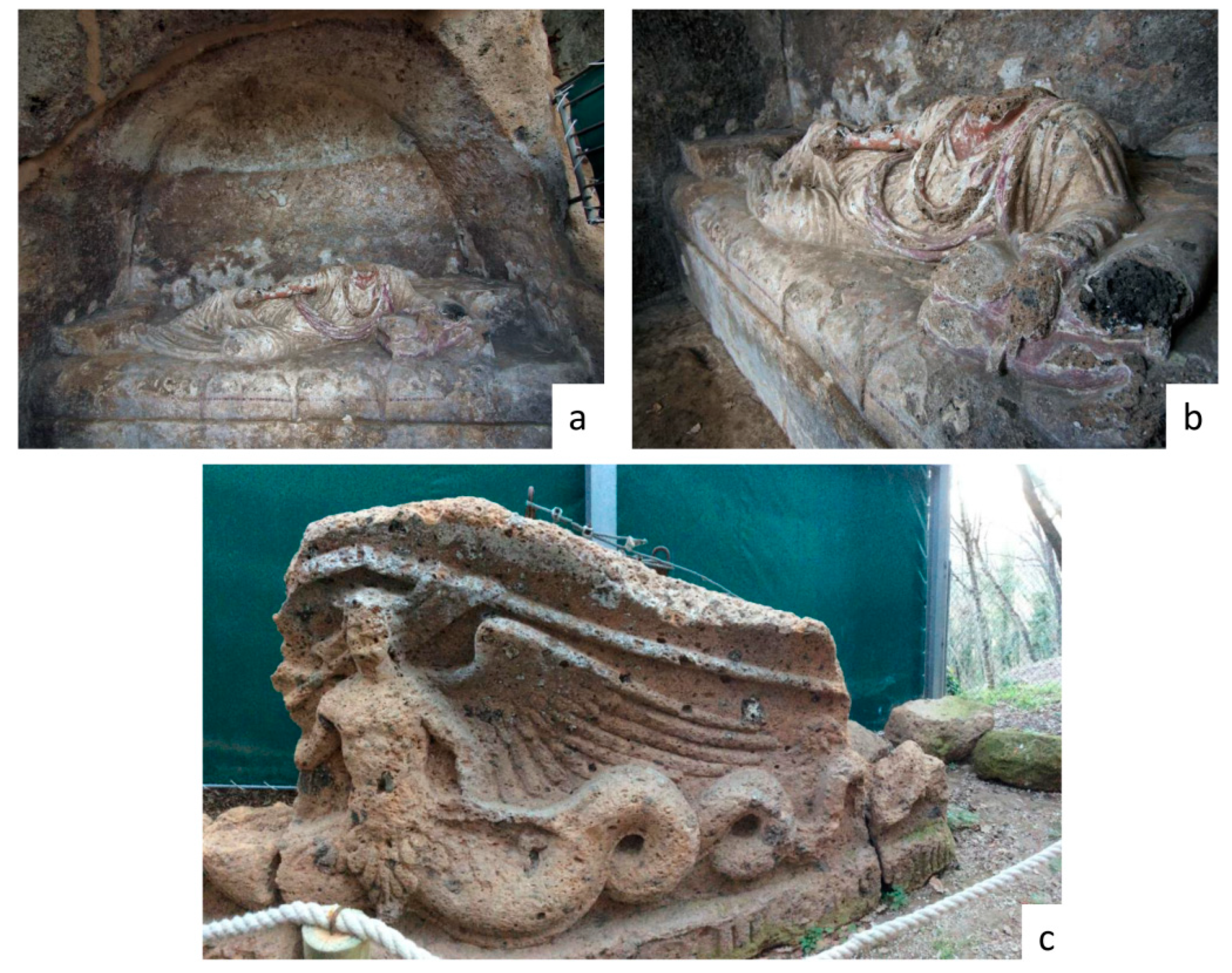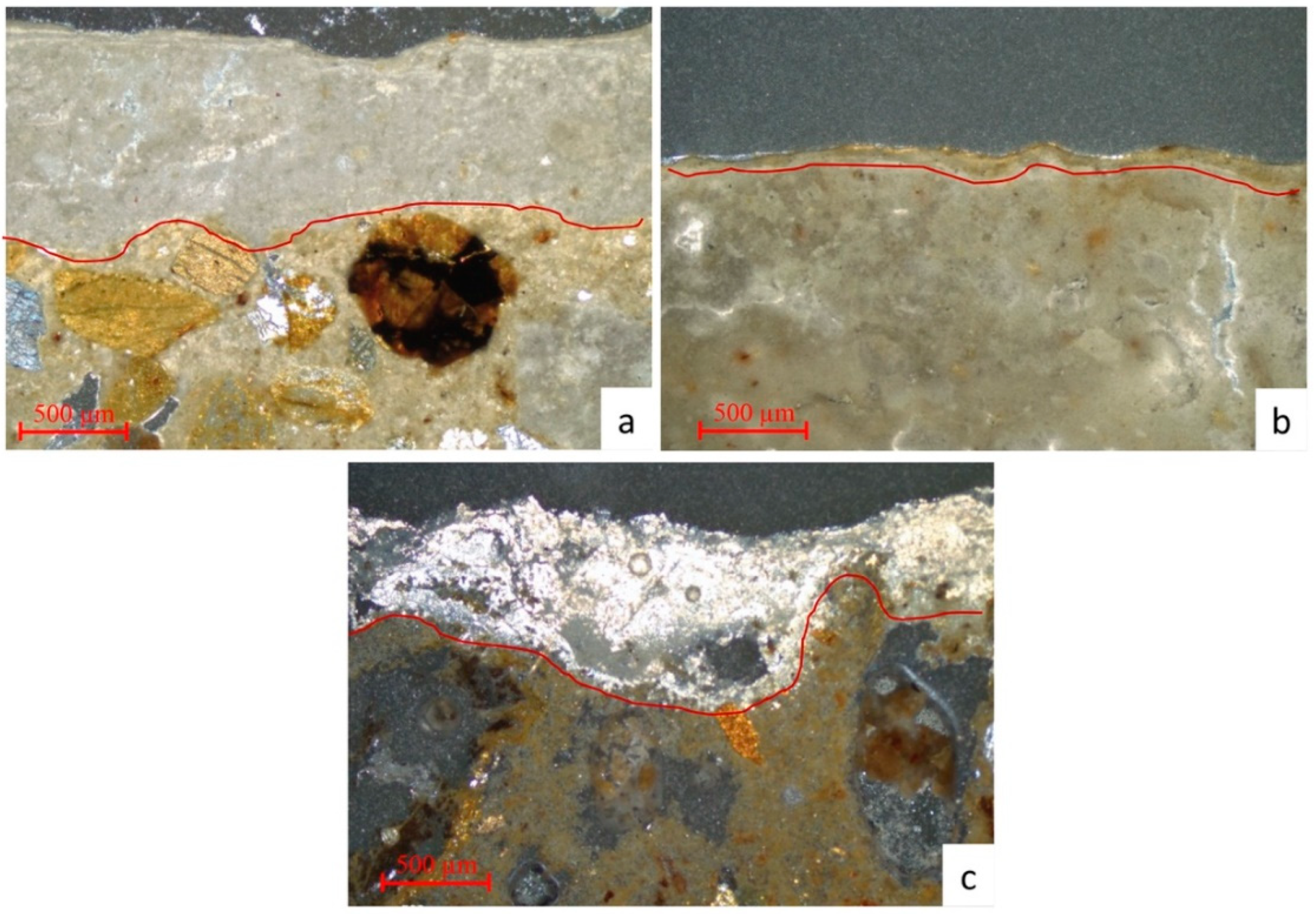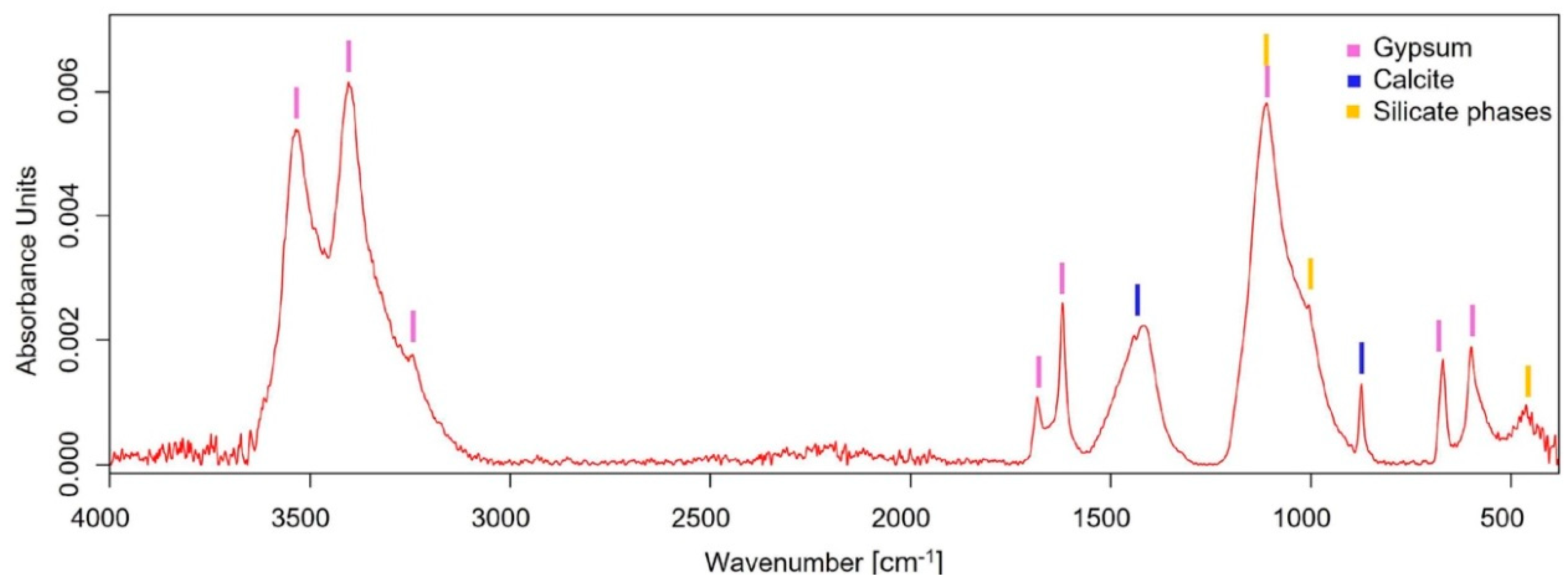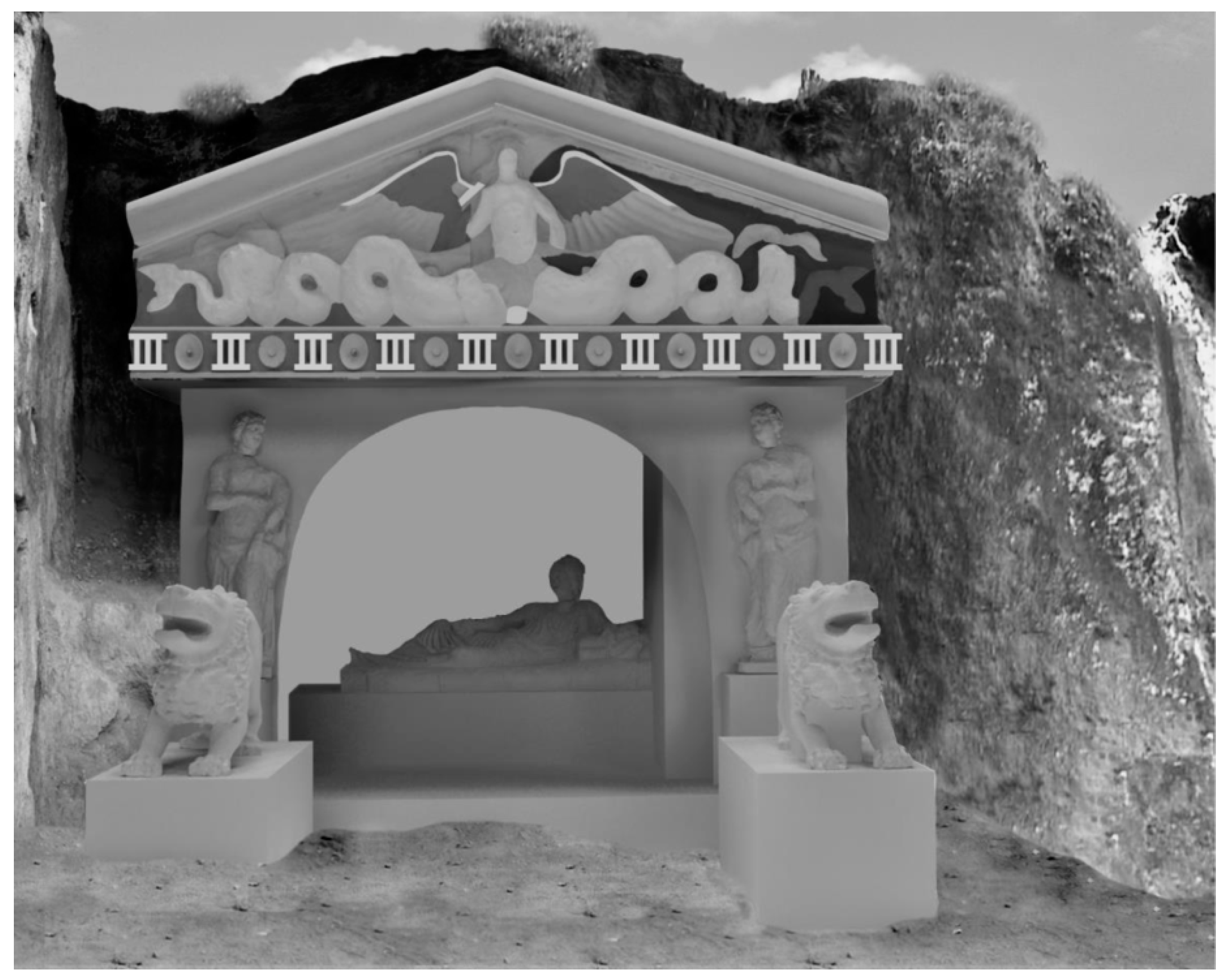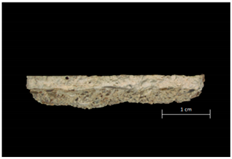1. Introduction
The Tomba dei Demoni Alati is located in the Etruscan necropolis of Sovana (Grosseto, Southern Tuscany, Italy). In this area, at the end of the 1990s, archaeological researchers revealed the remains of an aedicule tomb, carved into red tuff, which, for a long time, remained covered by the soil. In the summer of 2004, during further excavation work, a large part of the structure of the Tomba dei Demoni Alati was found, including new important figurative elements.
Based on its architectonic and figurative style, this tomb is dated to the end of the III century BC [
1]. Due to its characteristics, the Tomba dei Demoni Alati is considered the most important example of an aedicule tomb, having a recumbent male figure at a banquet [
1,
2,
3].
The discovery appeared exceptional because the sculpted surfaces maintained a large amount of their original polychromy, underlining an essential aspect of the Etruscan artistic production: the use of colors on sculpted and architectural structures. Due to the high porosity of the red tuff, the Etruscans needed to use different methods to decorate the rock surface, which was particularly difficult to paint. For this reason, the porous and irregular surface of the tuff was modelled and coated with specific materials, making the surface suitable for painting.
Moreover, in the particular environmental context, the application of high-cohesion and low-porosity preparatory layers provided further effective protection of the sculpted surfaces of the tomb [
4,
5,
6,
7,
8].
To complete the analytical investigation of the decorative and pictorial techniques used on the Sovana tombs, after the characterization of the polychromy [
1,
9], we focused our attention on the study of the preparatory layers. Minero-petrographic (XRD, PLM), chemical (ATR–FTIR), and micro-chemical (SEM–EDS) characterization was carried out. The main purpose of our work, due to the lack of studies on this topic, was to identify the manufacturing techniques and materials used by Etruscans on the preparatory layers, according to the architectonic typologies and/or sculptures. The data allow us to determine the use, for the first time, of plaster in Tuscany, as a technological innovation by Etruscan workers, in addition to the discovery of a particular preparation layer not observed in any other archaeological context.
Geological Context of the Necropolis
The necropolis of Sovana is located in the so-called “Vie Cave” area [
10]; it consists of a suggestive road network, dating back to the Etruscan civilization period, which connects various settlements and necropolises mainly located in the area encompassing Sovana, Sorano, and Pitigliano (
Figure 1).
This area is characterized by the occurrence of extensive pyroclastic deposits and some lava flow from eruptions of the Latera volcano 0.38–0.15 Ma ago [
11]. These deposits consist in one of the two complexes forming the Monti Vulsini volcanic district, which was incised by a parallel network of deep gorges [
12,
13]. According to [
14], the Latera stratovolcano emplaced seven pyroclastic formations, i.e., Canino, Farnese, Sovana, Sorano, Grotte di Castro, Onano, and Pitigliano. The eruptive activity of the Latera volcano ended in the lower Pleistocene. In this period, the area of Sovana was characterized by a morphology of large flat areas slightly inclined towards the southeast, characterized by volcanic grounds. From the lower Pleistocene to more recent historical times, the large plains were remodeled by the erosive action of the superficial stream waters, which heavily modified the initial geomorphology.
Differential erosion has deeply modified the surface, creating tight valleys with subvertical walls, connected by large, lithified deposits, and generating walls showing minor inclination in correspondence to the cineritic layers, having low coherence. The morphologic dynamic of the slopes was also influenced by the gravitative processes responsible for the detachment of large blocks from the immense vertical walls, either because of weakening at the foot, or the presence of fractures due to the action of plant roots. The lithoid slopes moved back, forming plains, with terraced features, parallel to the valleys [
15]. These processes were primarily responsible for the falls along the valley slopes, making it possible to build the architectural structures of the tombs. At the Etruscan time period, the large plains, slightly inclined towards the southeast, were already crossed by the several valleys, visible today.
In this morphologic context, the Etruscan population had the opportunity to take advantage of the natural shape of the territory. The upper plains were used for settlements and agriculture, the lower valleys for the main roads, and the flat surfaces along the valley walls to build the main necropolis of Sovana (Poggio Grezzano, Sopra Ripa, Folonia, Il Cavone, and Poggio Prisca) [
16]. The architectonic parts of the tombs were made out of the almost vertical lithified walls of the red tuff, containing black slag of the Sovana eruption in correspondence with the slight terracing existing at the passage of the tuff with the cineritic layers, accessed from the valley bottom. Where the thickness of the tuff did not allow for the making the whole tomb, the dromos and the funerary chambers were carved inside the underlying cineritic layer, which had scarce cohesion. This layer was subject to a rapid process of degradation, which often resulted in the collapse of the structure itself and, later, in the partial or complete filling of the hypogeum.
The construction of the aedicule tombs by excavating the back tuff wall allowed the structures to be protected from erosion due to surface runoff water along the slope and the erosive action of wind.
With the abandonment of the necropolis by the Etruscans, the gravitational processes of the slopes, and the plant growth, in particular, the mechanical action of tree roots, affected the tombs, contributing to the destruction of the architectonic structures. Consequently, fractures were produced and, successively, the detachment of the rock fragments of the walls was unavoidable [
17]. The tuff blocks covered by debris, and then by the ground, were able to preserve the sculptural decorations and, in part, the remains of painting. Nowadays, the presence of paint traces in numerous tombs (Tomba Ildebranda, Tomba Pola, and Tomba dei Demoni Alati) testifies to the characteristics of the decorative apparatus of the necropolis of Sovana.
2. Tomba dei Demoni Alati
The Tomba dei Demoni Alati (
Figure 2), at the moment of the discovery, looked greatly decayed because of the detachment of the tuff wall behind the tomb. A large cubic block carved into the red tuff was still in place, and a large central partially buried niche opened and allowed a glimpse of a reclining figure carved inside. The removal of the ground from the vaulted niche (
Figure 3a) revealed the sculpture of a recumbent male figure on a
kline (funeral bed) while he was at a banquet (
Figure 3b). On the side of the niche, under the pediment, there are the remains of two high podiums, in which two female figures were originally sculpted: they represent two Vanth, demons with two large wings. The detachment of the wall behind the tomb caused the sliding of large blocks of the aedicule, responsible for the collapse of the pediment and the two female figures. The pediment, with the sculpture of the great sea demon with wings, depicting the nymph Scylla (
Figure 3c), was found upside down in front of the niche, together with blocks and debris belonging to part of the aedicule and the only partially preserved sculptured female figures [
2,
9,
18,
19]. The tomb was located in the middle of a plateau, approximately seven meters wide (
Figure 2), consisting of a parallelepiped structure obtained by digging two deep trenches in the tuff. On the left trench, some steps at the rear of the structure allowed access to its top. Two lions, guardians of the tomb, stood symmetrically on a high podium on the plateau in front of the facade. Of these, only the left one has survived (
Figure 2).
3. Materials and Methods
The small samples (three for each different architectonic location) of the preparatory layers were collected by the niche, the recumbent figure, and the pediment, respectively (
Table 1); in addition, a sample of the tuff rock, underlying the preparation layers was analyzed. Each sample was first observed through a stereomicroscope (Leica DMS 300) in order to collect the microscopic features and to prepare thin and/or polished sections.
The identification of the constitutive layers of the paint (presence of plaster, presence and number of preparatory layers), the measuring of the single layer thickness, and the assessment of the morphologic and minero-petrographic characteristics, were carried out by means of polarized light microscopy (PLM) (ZEISS Axio Skope.A1 microscope, equipped with a video camera of 5 megapixel resolution) and image analysis software (AxioVision) [
20,
21].
Mineralogical analysis was carried out to obtain the compositional characteristics of the preparatory layers, utilizing an X-ray Powder Diffractometer (XRPD) (Philips PW 1050/37) with a Panalytical X’Pert PRO and HighScore software data acquisition and interpretation system. The adopted operating conditions of the instrument were 40 kV–20 mA, Cu anode, graphite monochromator, and 2/min goniometry speed in a scanning range between 5–70° θ; the slits were 1-01-1 and the detection limit was 4%.
The chemical analysis was performed by using Fourier Transform Infrared Spectroscopy (FT-IR) through ATR mode with a Spectrum 100 FT-IR spectrometer (PerkinElmer Inc., Norwalk, CT, USA) equipped with a universal ATR accessory. The acquisition was carried out at room temperature in the spectral range between 4000 and 350 cm
−1, repeating 24 scans with resolution of 4 cm
−1. The data were acquired and processed using Spectrum 100 software [
20].
Morphological and semiquantitative micro-chemical analyses were performed by means of a SEM–EDS electronic microscope (ZEISS EVO MA 15) (Carl Zeiss, Jena, Germany) with W filament equipped with an analytical system in the dispersion of energy EDS/SDD, Oxford Ultimax 40 (40 mm
2 with resolution 127 eV at 5.9 keV) (Oxford Instruments, Abingdon, UK) with Aztec 5.0 SP1 software. The measurements were performed on carbon metallized thin sections of the samples on binder and lumps using the following operating conditions: acceleration potential of 15 kV, 500 pA beam current, working distance comprised between 9 and 8.5 mm; 20 s live time as acquisition rate used to achieve at least 600,000 cts, on a Co standard, and process time 4 for point analyses; and 500 µs pixel dwell time for maps acquisition with 1024 × 768 pixel resolution. The software used for the microanalysis was an Aztec 5.0 SP1 software that employs the XPP matrix correction scheme developed by [
22]. This is a Phi-Rho-Z approach that uses exponentials to describe the shape of the φ (ρz) curve. XPP matrix correction was chosen because of its favorable performance in situations of severe absorption, such as the analysis of light elements in a heavy matrix. The procedure is a “standard-less” quantitative analysis that employs pre-acquired standard materials for calculations. The monitoring of constant analytical conditions (i.e., filament emission) was achieved with repeated analyses of a Co metallic standard.
4. Results
The obtained minero-petrographic, chemical, and micro-chemical data are described by listing them according to the different architectonic locations, i.e., niche, recumbent figure, and pediment, respectively.
The niche rock substrate (
Figure 3a) is covered by two finishing layers: the outer thin white preparation is overlapping a layer of plaster in contact with the tuff. Occasionally, the plaster does not show good adhesion, and is mostly detached from the surface of the rock. The microscopic observations, under the polarized light microscope (PLM), highlight the first preparation layer onto which the color was applied, constituted by a Ca lime layer (the thickness is approximately between 100 µm and >1.0 mm). The lime contains sporadic tuff inclusions (600–800 µm in size), a medium–low porosity, and some fractures. Below the first layer, a mortar (thickness >2 mm), realized with an air-hardening calcic lime binder of anisotropic aspect and micritic texture, is present; the aggregate, dispersed in the binder, is well-sorted with subrounded shape. The binder/aggregate ratio is approximately 2/3. The carbonate binder, which includes numerous lumps (400–900 µm in diameter), displays a porosity consisting of irregular voids with dimensions rarely greater than 400 µm. The main components of the aggregate are represented by rounded crystals of sanidine (0.3–1.1 mm), pyroxenes (400–600 µm), and rounded fragments of siltstone (400–900 µm), in addition to tuff, and metamorphic and sandstone fragments (
Figure 4a).
The finishing of the sculpted parts inside the niche (recumbent figure and
kline) (
Figure 3b) is constituted by two preparatory layers. The outer one is of white color (variable thickness between 30 and 150 µm) and had the function to make possible the painting; the layer applied below (thickness between 350 µm and 2 mm) had a double function, which was to smooth the rock surface and to enable to model different parts of the sculpture. Both of them are constituted by a Ca lime layer similar to that used in the outer layer of the niche. The lime layers have a porosity of small dimensions (<0.4 mm), (mostly due to drying-out fractures), numerous lumps, and tuff fragments (rare, apart from where they are in contact with the substrate) (
Figure 4b).
The preparatory layer to the color used for the decorations of the sculptured surfaces outside the niche (pediment and winged figure) is significantly different from those previously described (
Figure 3c). This layer is white but translucent, and has a reduced thickness (30–300 µm) with respect to those of the niche. It appears compact and isotropic, without any inclusion (
Figure 4c).
The mineralogical data (
Table 2) obtained by X-ray diffractometry, confirm the petrographic observations on the three architectonic locations. The outer layers of the niche show a calcite composition constituting the Ca lime layer, while in the plasters are mainly present calcite, quartz, feldspar, pyroxene and, in trace quantities, phyllosilicate and zeolite. Inside the niche, over the recumbent figure and
kline, the outer lime layer shows a composition with calcite and traces of pyroxene and zeolite. In the underlying lime layer, in contact with the rock, only calcite is present. In the pediment, the XRD data show zeolite (chabazite) and k-feldspar (sanidine), in addition to traces of calcite, quartz, and gypsum (
Figure 5).
The results of the chemical analysis (ATR–FTIR) (
Table 3) confirm the mineralogical data. Present in the outer layers of the niche are mainly calcite and small amounts of silicates; only in the sample N2 weak absorption bands of gypsum are observed. In the underlying layers are present calcite and silicate phases belonging to the plaster. In the recumbent figure and the
kline, the outer and inner layers are mainly constituted by calcite and a weak presence of silicate phases. In the pediment, the presence of gypsum and calcite, as well as weak silicate phases, are highlighted. This can be observed in
Figure 6, representative of the FTIR spectrum interpretation (P1 sample) with corrected baseline and ATR correction. The presence of gypsum (CaSO
4∙2H
2O) is evidenced by the vibrational bands at 1108, 669, and 596 cm
−1, as well as the stretching and deformation vibrations of the O–H bond of water at 3525, 3492, 3401 cm
−1 and at 1692 and 1627 cm
−1, respectively. The stretching vibrations of calcium carbonate (CaCO
3), which peaked at 1420 and 875 cm
−1, are also shown. The silicate phases are weakly shown around 1000 cm
−1, hidden by the intense band of gypsum.
The micro-chemical analysis (SEM–EDS) of the niche samples shows, in the outer layer, a prevalent Ca-based composition, whereas in the layer below, in addition to Ca, the elements Fe, Si, and Al are also detected; in the surface of the outer layer, Si is also present (
Figure 7a).
In the surfaces belonging to the recumbent figure, a prevalent Ca composition is evident in both the layers, while in the surface, Si is also observed (
Figure 7b).
In the unique layer of the pediment sample, Si is prevalent, but on the surface, Ca and S are also detected (
Figure 7c).
Figure 7.
SEM maps of chemical elements in the samples collected by (a) the niche, the first preparatory layer and the plaster below; (b) the recumbent figure, the two lime layers; (c) the pediment, the unique white layer. Fe, green; Si, pink; Al, blue; Ca, yellow; S, cyan.
Figure 7.
SEM maps of chemical elements in the samples collected by (a) the niche, the first preparatory layer and the plaster below; (b) the recumbent figure, the two lime layers; (c) the pediment, the unique white layer. Fe, green; Si, pink; Al, blue; Ca, yellow; S, cyan.
The micro-chemical analysis of a white surface fragment collected by the winged figure in the pediment shows a predominantly SiO
2 composition, whose content is around 96% (
Figure 8a,b).
5. Discussion and Concluding Remarks
Due to the characteristics of the tuff that constitutes the necropolis of Sovana, Etruscans adopted special pictorial techniques to apply the color to the different architectonic and sculptures typologies.
The workers, before painting, had to carve the tuff. This is not a difficult stone to carve; however, it shows peculiar characteristics, such as high and irregular porosity, which make it difficult to paint its surface without a suitable preparation process. Moreover, the tuff color (red with black slags) is not neutral, and the color nuances applied onto it do not appear as desired.
Due to these difficulties, the Etruscans understood the necessity of applying specific materials to seal porous features and, even, to smooth them out. In particular, in the Tomba dei Demoni Alati, which is the object of this study, the cladding and finishing of the surfaces represent different approaches in relation to the choice of the decorative typologies.
The decoration of the niche was realized by the application of the colors onto a thin white preparatory layer constituted by Ca lime: this layer was laid over an air-hardening calcitic lime plaster realized with well-sorted aggregate, mainly constituted by sanidine crystals (0.3–1.1 mm) and pyroxene, as well as metamorphic, siltstone, tuff, and sandstone fragments. From the nature of the binder and the aggregate, it was possible to identify the origin of the raw materials used in the manufacture of the limes and of the plaster. Volcanic minerals come from the necropolis area, sculpted in tuffaceous rocks [
12,
13,
23,
24,
25], whereas the sedimentary and metamorphic minerals probably come from the nearest valley of the Fiora river, which crosses the silicatic and carbonatic rock outcrops [
26,
27,
28,
29,
30]. From a quality point of view, the presence in the plaster of lime lumps and carbonatic rock fragments, only partially transformed by thermic action, indicates inefficient burning, which implies little technological skill in lime preparation. In addition, the frequent drying out of fractures, and the high porosity due to air bubbles, found in the thickness of the plasters, indicate that the mixture was not always homogeneous.
The mineralogical results regarding the preparation layers of the niche confirm the petrographic observations, while the chemical and micro-chemical data highlight the presence of silicate phases in the surface, probably due to the pollution of the tuff ground during burial (see in
Table 2 and
Table 3 the composition of the tuff rocks).
In the sculpted parts, as in the recumbent figure and kline, the petrographic data show a white layer in contact with the rock substrate of higher thickness, which is constituted by Ca lime covered by a thinner layer, with the same composition, over which the color is spread. Both the layers are of the same nature, such as the one used in the finishing layer of the niche surfaces. The mineralogical and chemical results show the presence of different components, as silicate phases belonging to pyroxene and zeolite of the tuff debris, where the sculptures were discovered.
In addition, another technique was used in the pictorial decoration of the pediment and the winged demon figure. In this case, the color was only applied onto a unique thin white preparatory layer of a different nature with respect to that previously described. This layer is mainly constituted by silica, as shown in the micro-chemical analysis, where the content of SiO2 is approximately 96%. It can be assumed that the thin white layer is constituted by amorphous silica, not detectable in both XRD because of the amorphous phase, and also not visible using ATR–FTIR due to the high presence of other silicate phases. The layer was applied to cover the porosity of the substrate, and to obtain a predominantly smooth and opalescent white support upon which to spread the color.
The silica material was probably dispersed in a protein-based binder. The ATR–FTIR analysis was unable to determine the presence of a protein binder. This can be deduced by the data resulting from chemical analysis via GC/MS gas chromatography coupled with mass spectrometry, carried out on a white silica layer belonging to the Tomba Ildebranda pediment, previously studied by [
31], and showing the presence of protein material. It is possible that the amorphous silica derives from the use of diatomaceous earth, which is an easily-pulverized white material. This hypothesis is based on the wide availability of this type of material close to the Mt. Amiata volcanic apparatus, located close to Sovana [
23]. The microscopic analysis does not provide evidence for the presence of microorganisms usually found in diatomaceous earth, but this could be due to the accurate grinding of the original material.
In the preparatory layers of the pediment and winged demon figure, consisting only of a white silica layer, the XRD data show such minerals as zeolite (chabazite) and k-feldspar (sanidine) belonging to the tuffaceous soil where the remains of the tomb had fallen. In addition, traces of calcite, quartz, and gypsum are highlighted, probably of secondary origin due to the long burial period. These data were confirmed by the chemical and micro-chemical analyses, which show, in the white layer, the presence of silicate phases, and also calcite and gypsum on the surface.
The characteristics of the different types of materials identified for the preparatory layers seem to satisfy the need to carefully and correctly decorate the surfaces with various details and sculptural depths. Indeed, the tomb, which remained completely underground until the archaeological excavation in 2004, still shows large areas of plastered and colored surfaces. The loss of the plaster was, however, almost complete in those areas that remained outside the burial site [
2].
It is important to note that the data obtained by this research allowed us to highlight both the use of a plaster by Etruscans for the first time in Tuscany and also the applying of an original white silica layer, never found in any other archaeological context.
Finally, for the purpose of the restoration of Tomba dei Demoni Alati, a rendering of the original architecture, based on laser scanning of the remains that emerged from the excavation, allowed us to better evaluate the architectural and figurative significance of the tomb at the time of its edification (
Figure 9).
